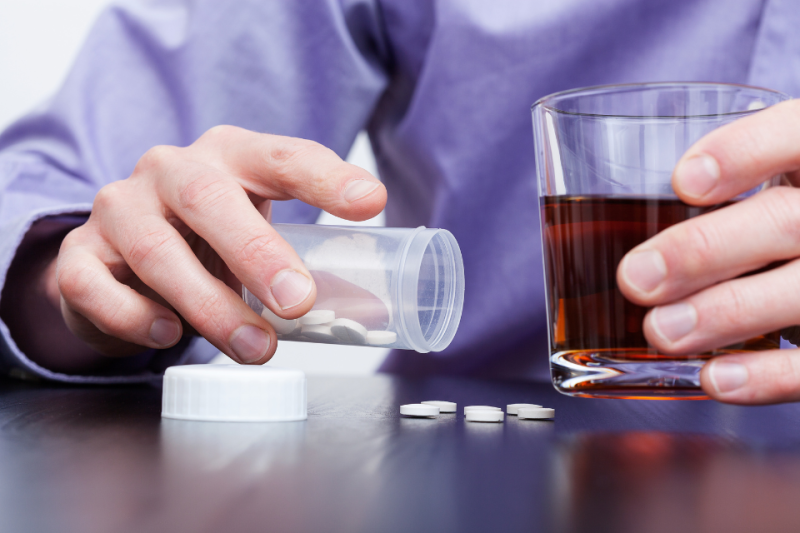
Intervening to reduce alcohol use is associated with a lower likelihood that an individual will receive a new opioid prescription or develop an opioid use disorder, according to a study led by researchers at Duke University and the Durham Veterans Affairs (VA) Medical Center.
The research, which appears in the May 6 issue of the American Journal of Psychiatry, suggests that delivering a brief alcohol-related intervention coincided with less opioid use, fewer opioid use disorder diagnoses, and potentially fewer opioid-related emergency department visits and hospitalizations.
“People are still dying. People are still struggling with addiction. People are still struggling to taper down opioid use. We can’t rest on our laurels. Instead, we need to look at different avenues where we can make improvements.”
— Dan V. Blalock, PhD

“The opioid epidemic is something we’ve made a lot of progress on in a lot of ways, but there’s still much work to be done,” said lead author Dan V. Blalock, PhD, associate consulting professor in the Department of Psychiatry & Behavioral Sciences and a clinical research psychologist at the Durham VA’s Center of Innovation to Advance Discovery and Practice Transformation. “People are still dying. People are still struggling with addiction. People are still struggling to taper down opioid use. We can’t rest on our laurels. Instead, we need to look at different avenues where we can make improvements.”
The Link between Alcohol and Opioids
Simultaneous overuse of alcohol and opioid misuse is common. According to research from the National Institutes of Health, roughly 26 percent of people with an opioid use disorder consume high levels of alcohol. These individuals are more than two and a half times as likely to also have an alcohol use disorder than those without an opioid use disorder.* Additionally, people who binge drink (consuming four or five drinks in a single setting) are almost twice as likely to misuse prescription opioids, even after accounting for other relevant factors.
Alcohol use also undermines pain relief—the reason why many people take opioids. Initially, alcohol consumption can reduce pain sensations, much like opioids. However, high use of both substances over time can trigger an increase in pain sensitivity. As a result, a person may boost their alcohol and opioid use to achieve the same level of pain relief, increasing the risk of overdose and death.
With these factors in mind, Blalock and his team examined how reducing alcohol use could be a first-line defense to curbing opioid misuse.
“Many people use alcohol to self-medicate for some pain. But this creates a spiral because excessive alcohol use is associated with higher levels of chronic pain,” he said. “Reducing alcohol use may help with some of the pain issues that lead people to seek out opioids in the first place and prompt them to examine other lifestyle factors.”
Examining an Alcohol-Based Intervention
To determine whether addressing alcohol use could reduce opioid use, including new prescriptions, opioid use disorder, and hospitalizations, Blalock’s team studied the impact of an alcohol-based intervention.
“If you’re using opioids and alcohol, that really increases your risk of harm because they’re both depressants on the system. You’re more likely to have an overdose, some other medical event, or death.”
— Dan V. Blalock, PhD
“We know that alcohol use disorder and opioid use disorder co-occur at high rates. If you have one, you’re more likely to have the other,” Blalock said. “If you’re using opioids and alcohol, that really increases your risk of harm because they’re both depressants on the system. You’re more likely to have an overdose, some other medical event, or death.”
In a retrospective review study of medical records from almost 500,000 VA patients, the team determined that about 63,800 patients had elevated alcohol use. They also examined how many of those patients received a brief five- to 15-minute intervention in which providers explained the normative trends of drinking and the health effects of excessive drinking. Referrals for any necessary additional treatment may have been placed.
Among all study participants with elevated alcohol screenings, 72 percent were documented to have received the intervention. Within one year, 8.5 percent had a new opioid prescription, 1.1 percent received a new opioid use disorder diagnosis, and 0.8 percent experienced an opioid-related hospitalization. Patients who didn’t receive the intervention had higher rates of new opioid prescriptions and disorder diagnoses, and although not quite statistically significant, a strong trend toward more opioid-related hospitalizations as well.
Based on these results, Blalock and his team want to dive deeper into the relationship between reduced alcohol consumption and opioid use.
“I want to spend the next several years looking further into the impact of pulling back on alcohol. Even if you’re using opioids to the same extent, it makes sense that there would be less risk involved,” he said. “You’re taking away a risk factor, so there’s a chance that reducing alcohol could also reduce opioid-related harms.”
An Overlooked Approach
While the alcohol-based intervention examined in this study isn’t new, Blalock’s team is the first to assess its impact on opioid use.
“We were trying for some outside-the-box thinking. There’s nothing different happening here with this questionnaire and intervention,” he said. “Instead, we’re looking at an existing tool to see if it may have some effects that we’re missing on other problems that are also happening.”
The hope, he says, is that providers will recognize the value of conducting the annual alcohol screening and intervention and consider it to be part of their opioid risk mitigation strategy.
“We’re hoping that providers’ ears might perk up and that they will be sure to not only check these boxes because they have to, but actively look to administer this intervention anytime it might be indicated,” he said. “Doing so can contribute to building a strong alcohol-opioid surveillance system. And more concretely and directly, it might improve patients’ lives in more ways than we previously thought.”
“We’re hoping that providers’ ears might perk up and that they will be sure to not only check these boxes because they have to, but actively look to administer this intervention anytime it might be indicated. Doing so can contribute to building a strong alcohol-opioid surveillance system. And more concretely and directly, it might improve patients’ lives in more ways than we previously thought.”
— Dan V. Blalock, PhD
*Statistic derived from two sources: NIAA and “Co-Occurring Substance Use And Mental Disorders Among Adults With Opioid Use Disorder”
Funding for the study was provided by a U.S. Department of Veterans Affairs Health Services Research and Development Career Development Award 19-035 (IK2HXOO3085-01A2, K2HX003087), The Duke Endowment (grant 6754-SP SUB #21 P3630024), and the Center of Innovation to Accelerate Discovery and Practice Transformation at the Durham VA Health Care System (CIN 13-410).
CITATION: “Associations Between a Primary-Care Delivered Alcohol-Related Brief Intervention and Subsequent Opioid-Related Outcomes,” David Blalock, Sophia Berlin, Theodore Berkowitz, Valerie Smith, Charlie Wright, Rachel Bachrach, Janet Grubber. American Journal of Psychiatry, May 1, 2024. DOI: 10.1176/appi.ajp.20230683